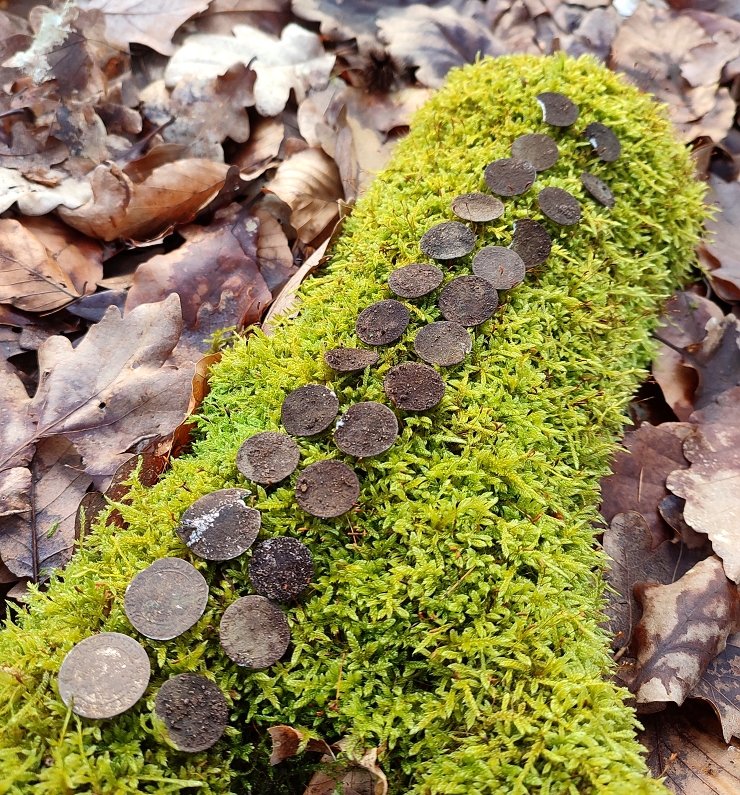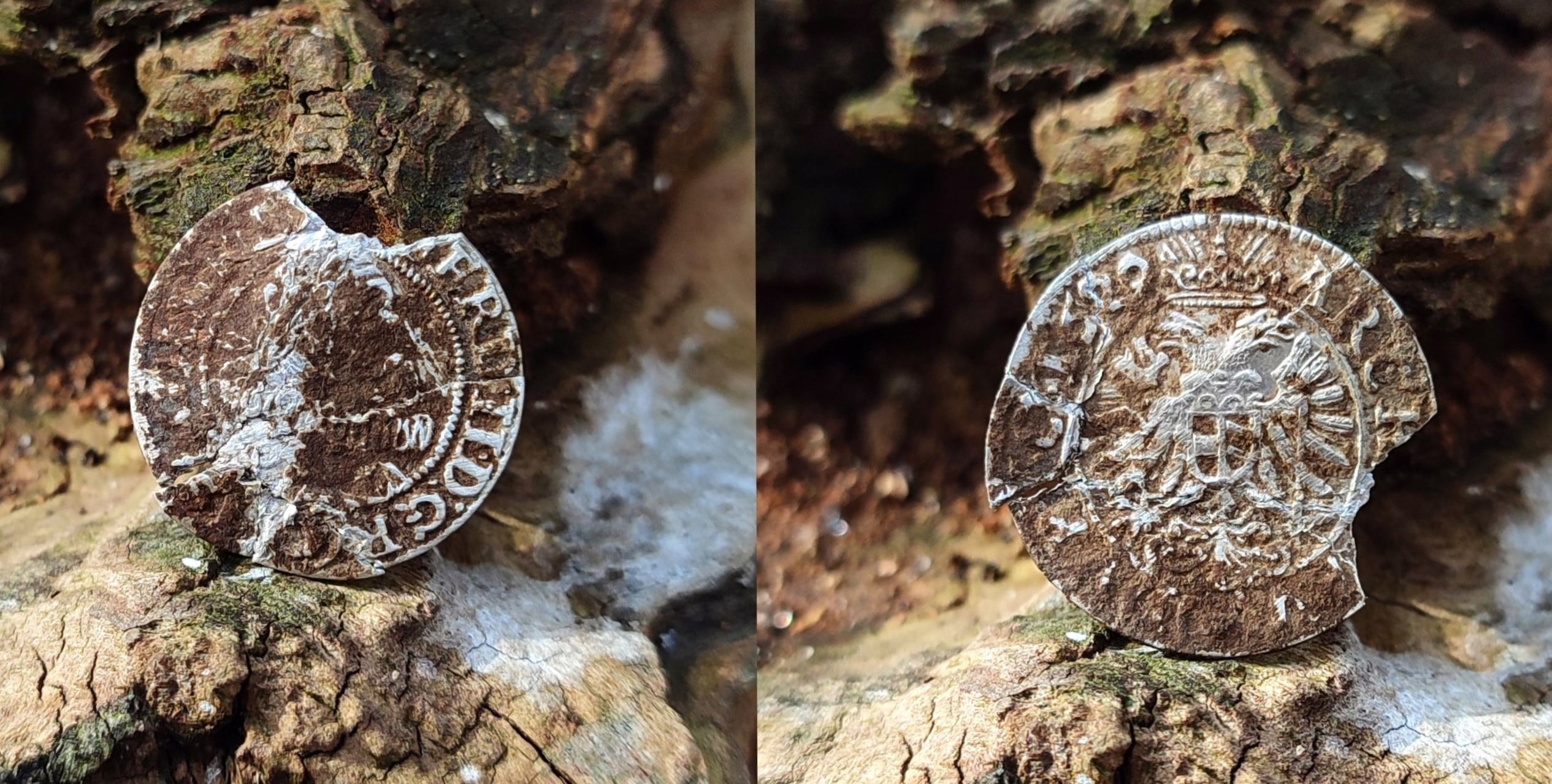Moc hezký článek a gratulace k nálezu.
Coin depot from the Thirty Years' War
Categories: Finds and rescue research in the Czech Republic

After much insistence, a friend recently got his first detector and is trying to get to grips with it. So last week we went out into the field again. Previous searches had been without much success in the field, so this time I suggested going into the woods to a location where he had alreadya few nice handcuffs, and where I kick everything in sight - the perfect place for a beginner.
Or so I thought. His talent for big irons has disappeared, and overall the search could be compared to Palo Habera's Advertisement for Silence. Right at the beginning he still complained that "something was pushing him". After about two hours of swinging on empty and a bit of iron mess, I suggest moving to a nearby woods along the road. We hung around there for a while, and as we were leaving, he announced, "I think I'll go home, I'm tired, I'm not enjoying it, and most of all I feel like shitting and I don't have any tissues". With these words he said goodbye and walked to his car. He offered me a ride, but I decided to stay and walk home.
So I went there alone. A few minutes later I was standing on the edge of a sparse oak forest, wondering where to start. From previous searches and maps, I know that there are some nice drives in the back of it, and that I'm not the first person to find it, judging by the distinctive square holes. A small bare patch catches my eye from a distance, on the border between deciduous and coniferous trees, and there also seems to be a blueberry in combination within combination with the fallen leaves form strange long strips, which perhaps seem to line the otherwise invisible paths in the terrain.
I put on my headphones and set off, reach the spot, and immediately get a clear signal, ID 13/14. After a while, the first coin is revealed - a 3 kreutzar from 1624. Delighted, I take a photo, bag it up, bury the hole and continue. Half a metre away, another signal, ID 8/9. I stick the scoop in again and surprisingly it's another coin, this time a one-krejcar. I swing again next to the hole, and another signal, and another, and another. What follows is about an hour of tracking and digging up even the faintest signalssome of the pieces reported as ID 1 from deep down, or were so fragile that they were almost impossible to pick up between the fingers.
In total, on an area of about 3x3 metres, we managed to find a total of 32 kreutzers, consisting of 23 one-kreutzers and 3 three-kreutzers. Given the nominal composition of the coins and the relatively small amount, this is probably not a hoard, but rather a loss. According to the legible coins, with the exception of one case, these are only the coins of Ferdinand II from 1624 to 1631. Further cleaning and conservation is in the hands of experts from the Museum of East Bohemia in Hradec Králové.
The coins determined so far
3 krejcar 1624 mint Kutná Hora, mintmaster Šebestián Hölzl
3 krejcar 1626 mint Víden, mintmaster Matthias Fellner
3 krejcar 1629 mint Vratislav, mintmaster Riedler+Ziesler
1 krejcar 1628 mint Mikulov, mintmark N (Nikolsburg), 2 pcs
1 krejcar 1631 mint Olomouc, mintmaster Martin Fritsch, 2 pcs
1 krejcar 1625 Ferdinand III as titularKing, mint Kladsko, mintmaster Petr Hema
1 krejcar 1629 Charles Eusebius Liechtenstein, mint Opava, mintmaster Wilke
1 krejcar 1625 mint Nisa-Tyroly
Conversion rates, wages and prices around 1630
At the beginning of the 17th century, the main monetary units were the tolar and krejcar, the Rhenish gold piece, Bohemian and Meissen grosz, denarii and pfennigs.
1 thaler = 1 rhenish gold piece + 10 kreuzers = 70 kreuzers = ½ kopek of Czech groschen = kopek (60 pieces) of Meissen groschen = 210 denarii (white money)
Wages
Carpenter (year 1611): 2 groszy/day and board
Carpenter: 10 kreutzers/day
Pacholek (year 1630): 14 gold pieces/year
Grass cutting (year 1611): 1 groschen and 2 denarii/day
Sowing or cutting grain (year 1628): 30-36 denarii/day
Bricklayer (year 1629): 70 denarii/day
Prices
Chicken: 5 kreutzers
A pile of eggs (year 1631): 15 kreutzers
A peck of bread (year 1622): 7 kreutzers
1 measure of bread flour (year 1622): 2 golden
1 measure/62 liters of rye (year 1631): 1 gold and 8 kreutzers
Cow (year 1630): 6 gold
Calf (year 1636): 1-2 gold
Horse (year 1616): 30-32 gold
Ram (year 1630): 2 gold
Goose (year 1630): 15 kreutzers
Flint (year 1615): 15 groschen
Coin consortium and the state bankruptcy of 1623
However, the ratios of the different denominations were not the same in the first years after the defeat of the Bohemian Estates on the White Mountain. For example, in 1616, 1 thaler was equal to 90 krejcars, in 1618 the thaler was worth 120 krejcars, two years later 150 krejcars, and in 1623, due to inflation, even 675 krejcars. After 1624, the value of the tolar returned to 90 kreutzers.
This significant fluctuation in the currency, together with the confiscation and sale of the property of the supporters of the Estates' Revolt, was caused by the efforts of Ferdinand II. to resolve the financial crisis in which the Habsburgs had been in since the end of the 16th century.In 1622, the emperor established a 15-member "coin consortium", which was granted a monopoly to mint its own coins in Bohemia, Moravia and Lower Austria for a price of 6 million gold pieces. It also had the exclusive right to purchase all silver and fine silver coins at predetermined prices. From 1 April 1622, a ban was issued on the payment of old coins, which were withdrawn from circulation by the members of the consortium and from which new coins of low purity and higher denomination were minted. As a result, the market was flooded with large quantities of low-quality currency. It is estimated that the Prague mint alone produced silver coins worth a total of 32 million gold coins in a single year. The inevitable culmination was therefore the state bankruptcy on 14 December 1623, which reduced the value of the coins by up to 90 percent and thus ruined all strata of society.
The main profit of the consortium was initially made by the difference between the purchase price of silver and the value of the coins struck, and later by the confiscation and forced sale of the Estates' property. The emperor proclaimed a pardon for all those who voluntarily confessed to other than Catholic beliefs or anti-government sentiments, and confiscated half of their property, the value of which he paid in worthless kipper currency.
In this way, Albrecht of Wallenstein also came into possession of a vast fortune, and by confiscations and the proceeds of coinage which he used to build, among other things, the Wallenstein Palace. -As Mikuláš Dačický of Heslov wrote: "Many a fool has acquired wealth and riches unjustly and unjustly by such an unusual in Bohemia, but customary in the world, which the Lord God will punish.". Of course, despite two decades of investigation, none of the members of this great fraud has ever been punished.

the krejcar in the trench

1 krejcar 1625, Nisa-Tyroly mint

1 Krejcar 1628

1 krejcar 1631, Olomouc, mintmaster Martin Fritsch

3 krejcar 1629, Vratislav, mintmaster Riedler+Ziesler

3 krejcar 1624, Kutná hora, mintmaster Šebestián Hölzl
3 krejcar 1626, Vienna, mintmaster Matthias Fellner

legible and designated coins

mints represented in the legible part of the depot
Useful links
- https://www.hs-liechtenstein.cz/mincovni_konsorcium_a_statni_bankrot_roku_1623.pdf
- https://www.sberatel.com/diskuse/sberatel/cim-se-drive-v-ceskych-zemich-platilo-a-co-se-dalo-z-vyplaty-koupit-12076
- http://otta.cechove.cz/platidla.htm
- https://is.muni.cz/el/1421/podzim2017/PV1B102/um/POCETNI_POMERY_I.pdf
- https://stribrnak.cz/bankrot-v-roce-1623/
The article is included in categories:
Post
Velice pěkně zpracováno  A gratulace k nálezu
A gratulace k nálezu 
Velice pěkný článek a opětovná gratulace k nálezu, pane kolego.
Je to hezky, když to padne :)
Gratulace, hezký nález. Jen bych to spíš definoval jako rozsyp.
Rozsyp nebo depot , vždyť je to jedno , hlavně , když je to doma
Pěkná infarktofa pane Brumla. 
Krása všecko 👍🙂
Krásný nález👍, pěkné počteníčko, zas jsem chytřejší 😊
Moc pěkný. Zajímavé čtení.Pro mne velká pecka.👍
Krásný psaní a nález supér. Velká gratulace. Jen tak dál šikulo.👍👍☘️☘️☘️☘️
Děkuji super článek:)
Moc pěkný nález a skvěle zpracovaný popis i počteníčko. Děkuji za příspěvek a přeji mnoho dalších nálezů, ať se daří ! 👏👍👌✊ Držím palce.
Krásně zpracovaná prezentace nálezu, pane 
Super 
Na mapě je Nisa správně ve Slezsku. U popisu mince chybička. Jinak hezký nález 





















